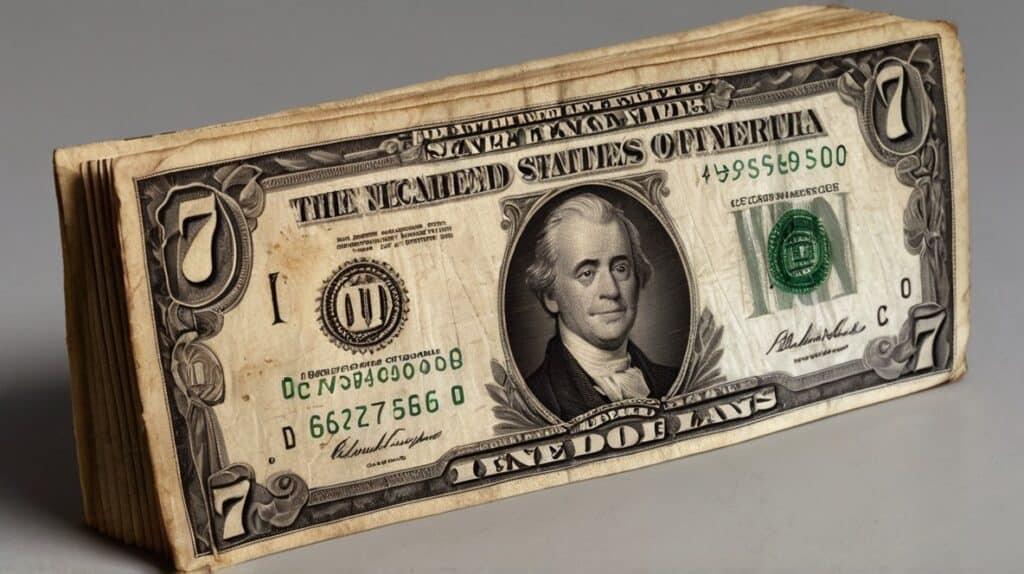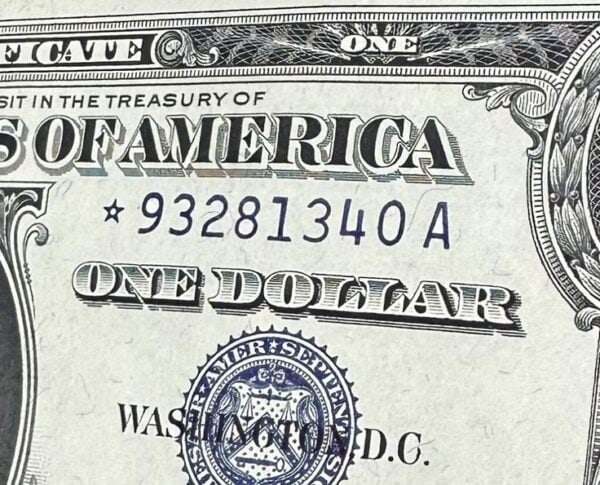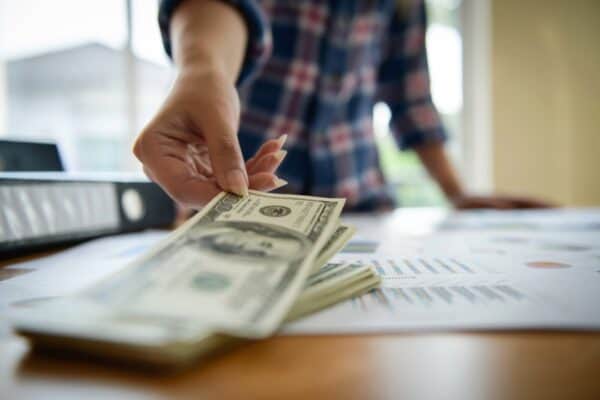Silver certificates were a unique form of currency the United States government issued from 1878 to 1964, holding a significant place in American currency history.
Among them, the 1950 $7 denomination stands out for its scarcity and intriguing features, offering a glimpse into the evolution of currency design and monetary policy during that era.
These certificates were backed by and redeemable for silver bullion or coins. The purpose of issuing silver certificates was to provide a convenient method for the public to hold silver without needing to possess the metal physically.
If you want to know how much is a 1950 7 bill worth, this article is for you!
Join me as I take you through the captivating world of dollar silver certificates and uncover the hidden treasures of the 1950 $7 bill.
You will learn more about the different series, the notable variations between them, and how to assess the silver certificate dollar bill value and authenticity of your own collection.
Key Takeaway
- Silver certificates like the 1950 $7 bill were a form of US currency backed by and redeemable for silver, providing a convenient way to hold silver wealth.
- Details like star notes, serial numbers, condition, and design variations contribute to the collectability and value of the 1950 $7 silver certificates.
- The certificates are no longer legal tender today but remain sought after by collectors for their historical significance and aesthetics.
- Assessing aspects like condition, rarity, demand, and unique serial numbers is key for collectors looking to buy or sell these certificates and understanding their fair market value.
Face Value of 1950 $7 Silver Certificates
The face value of a currency refers to the value printed on the bill. In the case of the 1950 $7 silver certificate, it signifies that the bill is worth seven dollars. However, it is important to understand that the face value of a currency does not always reflect its true worth.
$7 Face value in 1950 vs today adjusting for inflation
In 1950, $7 had greater purchasing power than today, primarily due to inflation. Considering inflation rates over time helps us understand this difference.
Adjusting for inflation reveals how the value of a $7 silver certificate from 1950 compares to its equivalent today. While $7 in 1950 could buy more goods and services then, its purchasing power in today’s dollars would be much higher due to inflation’s impact over the years.
Key Details on 1950 $7 Silver Certificate
1. Star Notes
Star notes represent a special category of currency that holds significant appeal among collectors due to their rarity and unique characteristics.
These notes are produced by the US Bureau of Engraving and Printing as replacements for regular currency that becomes damaged or flawed during the printing process. Instead of discarding imperfect bills, the Bureau replaces them with star notes, identifiable by a star symbol (★) preceding or succeeding the serial number.
The rarity and value of star notes stem from several factors. Firstly, they are produced in much smaller quantities than regular currency, as they are only used to replace defective bills. This limited production makes them inherently scarce.
Additionally, star notes are often considered to have a certain mystique or novelty due to their unique serial numbers and the circumstances of their issuance, making them highly sought after by collectors.
As for the specifics of the 1950 $7-star note, each note carries its distinct serial number and may exhibit varying degrees of wear or condition, depending on its history.
However, regardless of the specific serial numbers or condition, the mere presence of the star symbol designates it as a special and desirable variant of the 1950 $7 Silver Certificate, adding to its allure and collectability.

Credits: atticcapital.com
2. Serial Numbers
Serial numbers play a crucial role in identifying and categorizing currency, including the 1950 $7 Silver Certificate. Each bill is assigned a unique combination of numbers, typically printed sequentially. However, certain serial number configurations hold special significance to collectors, contributing to their perceived value.
In the case of the dollar Silver Certificates, serial numbers may vary in their rarity and desirability. Factors such as low printing numbers, interesting patterns (such as repeating digits or ascending/descending sequences), or specific combinations (such as “77777777” or “12345678”) can elevate the value of a bill.
Moreover, serial numbers associated with notable historical events, former presidents, or significant dates may attract collectors’ interest.
Understanding the nuances of serial numbers is essential for collectors seeking to identify valuable specimens within the 1950 $7 Silver Certificate series. Whether it’s a unique serial number combination, a low printing run, or historical significance, these numbers add an extra layer of intrigue and value to these collectible bills.
3. Silver Certificates as Legal Tender
Once a vital component of the United States monetary system, silver certificates were considered legal tender during their circulation period. However, they are no longer recognized as such today. Following discontinuing silver certificates, which ceased being issued in 1964, they lost their status as Federal Reserve Notes (Legal tender).
The shift away from silver certificates as legal tender occurred gradually. With the termination of the redemption of silver certificates for silver bullion by the United States Treasury in the early 1960s, their role in the currency system diminished. Additionally, introducing the Federal Reserve Note as the primary currency form further marginalized silver certificates’ use in transactions.
Today, silver certificates hold value primarily as collectibles rather than as functional currency. While they are no longer redeemable for silver or recognized as legal tender, they remain sought after by collectors for their historical significance, intricate designs, and unique place in American numismatics.
Condition Impacts Collectability and Value
In assessing the collectability and value of the 1950 $7 Silver Certificate, the condition of the bill plays a pivotal role.
To evaluate the condition of the currency, collectors rely on a standardized grading scale that ranges from poor to uncirculated. Within this spectrum, bills in uncirculated condition stand out as the most desirable and valuable specimens.
Uncirculated condition denotes that a bill has never been circulated in the economy, retaining its original crispness and sharpness of detail.
Such bills exhibit no signs of wear, folds, or creases, and their colors remain vibrant and intact. In the case of the 1950 $7 Silver Certificate, bills in uncirculated condition command a premium due to their pristine state and rarity.
Grading agencies and collectors meticulously assess various aspects of a bill’s condition to determine its grade, including the absence of folds, the presence of original sheen, and the sharpness of printing details. Bills in uncirculated condition are highly sought by collectors seeking the finest examples of numismatic treasures.
The exceptional condition of uncirculated notes contributes significantly to their collectability and value, making them prized additions to numismatic collections. As such, collectors often prioritize acquiring bills in uncirculated condition to preserve their beauty and historical significance for future generations.
Ties to Silver Coins and Bullion
The 1950 $7 Silver Certificate was closely tied to silver coins and bullion. It was backed by the silver reserves held by the U.S. Treasury, meaning each certificate could be exchanged for its equivalent value in silver bullion upon request.
Compared to physical silver coins like the Morgan silver dollars, used as legal tender, silver certificates offered a more convenient way to conduct transactions. While the Morgan dollar represented silver wealth in coin form, silver certificates allowed for value transfer through paper currency backed by silver reserves.
Unlike Morgan silver dollars, which had a fixed face value, silver certificates could be exchanged for silver bullion of any form, giving holders flexibility in their assets. This difference highlights the distinct roles of these currencies in the U.S. monetary system.
Silver certificates provided a unique way for people to own and use silver indirectly without needing physical coins.
Overview of Design Elements
The design elements of the 1950 $7 Silver Certificate encompass various visual and symbolic features, each contributing to its aesthetic appeal and historical significance.
These design elements signify the values and principles of the United States, reflecting the nation’s commitment to stability and prosperity. Collectors value these intricate details as they encapsulate American currency’s rich history and symbolism.

Here are key design elements of the 1950 $7 Silver Certificate:
- Portrait of George Washington: The central feature of the bill, George Washington’s portrait, symbolizes the founding ideals of the United States and the leadership of its first president.
- Seals: Incorporating seals such as the red seal of the United States Treasury and the red treasury seal, these elements authenticate the bill’s value and official status as legal tender.
- Text: Text throughout the bill includes denominational value, official declarations, and inscriptions such as “This certifies that there is on deposit in the Treasury of the United States of America Seven Dollars in Silver Payable to the Bearer on Demand.” These reinforce the bill’s status and purpose.
- Imagery: Imagery such as the olive branch and the heraldic shield symbolize peace, strength, and unity, reflecting the values of the United States as a nation.
- Colors: Distinctive colors, such as the blue seal, differentiate the $7 denomination and contribute to the bill’s visual appeal. Each color distinguishes various denominations within the series, aiding in easy identification.
Variations Between Series
The 1950 $7 silver certificate went through several series, each denoted by specific designations such as “Series 1950A” or “Series 1950B/ the B series.” These series showcase subtle yet noteworthy design, production, and signature differences.
Despite sharing the same denomination, collectors often find distinct serial number sequences across different series, with certain configurations considered more desirable due to their rarity or aesthetic appeal. These variations could include:
- Variations in printing: Differences in printing techniques or equipment used during the production of different series can result in variations in the appearance or quality of bills.
- Minor Design Changes: While the overall design of the $7 silver certificate remains consistent across series, minor design changes in design elements, such as the placement or size of certain features, set apart one series from another.
- Serial Number Sequences: Serial numbers on bills within different series may follow distinct sequences, ranging from sequential to random patterns. Collectors often seek out specific serial number configurations for their rarity or aesthetic appeal.
These notable differences highlight the evolution and diversity within the 1950 $7 silver certificate series, offering collectors a fascinating exploration of these historical artifacts.
Unique/Interesting Serial Numbers
Serial numbers on 1950 $7 silver certificates vary widely, and certain characteristics make them particularly captivating to collectors. A serial number’s uniqueness often lies in its sequence, which may deviate from standard patterns or feature memorable arrangements of digits.
Here are some rare serial numbers that stand out for their uniqueness or historical relevance:
- Repeating Digits: Serial numbers featuring repeated digits, such as “88888888,” “55555555,” or “33333333,” are highly sought after for their striking visual appeal and rarity.
- Sequential Sequences: Sequential serial numbers, such as “12345678” or “98765432,” are prized for their orderly arrangement and scarcity.
- Palindromic Numbers: Palindromic sequences, which read the same backward as forward, like “1234321” or “13577531,” are particularly fascinating to collectors for their symmetry and mathematical significance.
- Historical Dates: Serial numbers corresponding to significant historical dates, such as “17761776” or “14921592,” capture collectors’ attention for their ties to pivotal moments.
- Low Sequence Numbers: Bills with low sequence numbers, such as “00000001” or “00000100,” are highly coveted for their rarity and potential association with early production runs.
Whether it’s an unusual pattern, historical significance, or low sequence number, collectors are drawn to serial numbers that tell a story and add intrigue to their collections.
Buying or Selling 1950 Silver Certificates

The current fair market value of a 1950 $7 silver certificate can vary depending on its condition, rarity, and demand among collectors. Generally, bills in very fine conditions, particularly those graded as uncirculated, command higher prices in the market.
Additionally, serial number configurations and any unique or interesting features can influence the value of a bill.
Collectors can explore various avenues to buy or sell a 1950 $7 bill. These include online marketplaces, auctions, or engaging with currency dealers specializing in rare and collectible bills.
It’s essential to research recent sales and market trends to ensure fair pricing and informed decision-making in transactions involving these rare and valuable collectibles.
Wrap Up!
The 1950 $7 silver certificate represents a unique American currency history. Its ties to silver, interesting design elements, and rarity make it a desirable collectible among enthusiasts.
Whether you are a seasoned collector or intrigued by the historical significance of these bills, exploring the true worth of the 1950 $7 silver certificate can be a fascinating journey into the world of numismatics.
